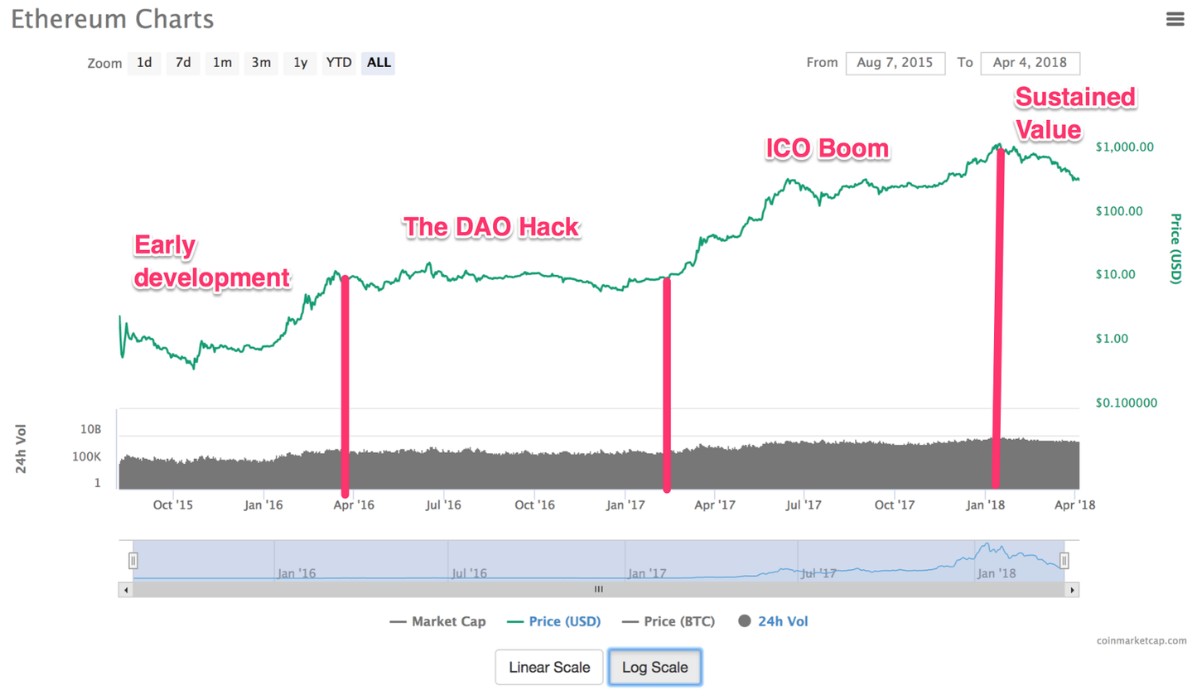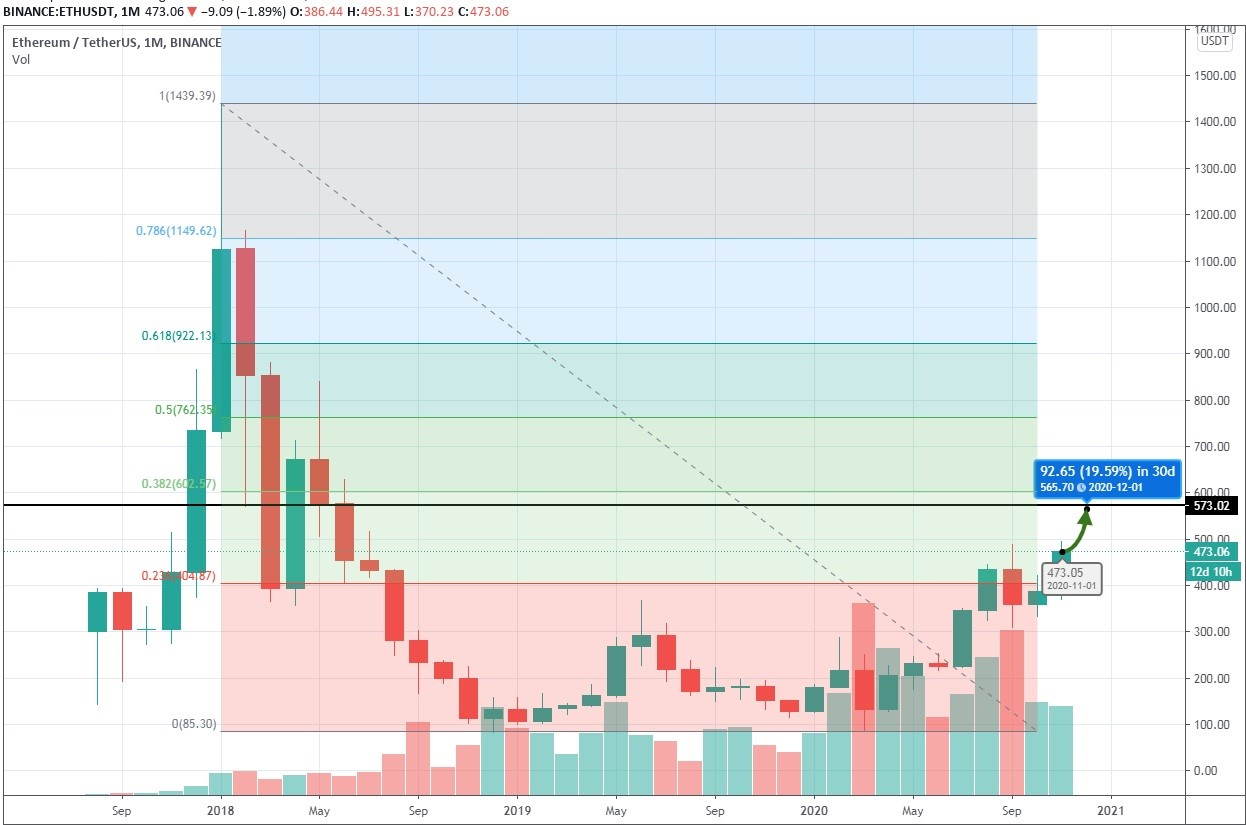Introduction
Welcome to our comprehensive analysis of Ethereum’s current market status and the factors contributing to its bottom. In recent months, Ethereum, the second-largest cryptocurrency by market capitalization, has experienced a significant decline in its value and market dominance. This has left many investors and enthusiasts questioning the future of this once-promising blockchain platform.
Understanding the reasons behind Ethereum’s decline is crucial for investors and anyone involved in the cryptocurrency market. By examining the various factors influencing its bottom, we can gain valuable insights into the potential for recovery and future growth.
Ethereum, founded by Vitalik Buterin in 2015, quickly rose to prominence as a decentralized blockchain platform supporting smart contracts and decentralized applications (DApps). With its native cryptocurrency, Ether (ETH), Ethereum revolutionized the way developers could build and deploy applications on the blockchain.
However, despite its initial success, Ethereum has faced challenges and limitations that have contributed to its recent downturn. In this article, we will delve into these factors and explore the broader market trends that have influenced Ethereum’s current market position. Additionally, we will examine the short-term prospects for Ethereum’s recovery and the potential catalysts that could uplift its value.
It is important to note that this analysis is based on current market conditions and expert opinions. As with any investment, we urge readers to conduct their own research and consult with financial professionals before making any decisions.
Without further ado, let’s explore the reasons behind Ethereum’s bottom and evaluate its prospects for future growth!
Understanding Ethereum’s Decline
Ethereum’s decline can be attributed to a combination of internal and external factors that have affected the sentiment and value of the cryptocurrency. It is essential to delve into these factors to gain a comprehensive understanding of why Ethereum has reached its current bottom.
One significant factor contributing to Ethereum’s decline is the increasing competition from other blockchain platforms. Ethereum was once the go-to platform for developers to create decentralized applications, but now faces stiff competition from newer platforms like Binance Smart Chain and Solana. These newer platforms offer faster transactions and lower fees, enticing developers away from Ethereum.
Another challenge Ethereum faces is scalability. As the popularity and usage of Ethereum have grown, the network has struggled to handle the increasing transaction volume. This has resulted in high gas fees and slow transaction processing times, making it less attractive for users and developers to utilize the platform.
In addition to scalability issues, Ethereum has also been affected by concerns over its energy consumption. The mining process of Ethereum, which relies on proof-of-work, has come under scrutiny due to its significant energy consumption. This concern has caused some investors and institutions to be cautious about investing in Ethereum, leading to a decline in demand.
Furthermore, regulatory uncertainties surrounding cryptocurrencies have also impacted Ethereum’s value. Governments and regulatory bodies worldwide are still grappling with how to regulate cryptocurrencies effectively. Heightened regulatory scrutiny and potential restrictions on cryptocurrencies have created a level of uncertainty, causing some investors to shy away from Ethereum.
Lastly, the overall market sentiment and volatility in the cryptocurrency market have also played a role in Ethereum’s decline. As one of the largest cryptocurrencies, Ethereum tends to follow the broader market trends. When the market experiences a bearish phase or heightened volatility, investor confidence in Ethereum can waver, leading to a decline in its value.
Considering these factors, it becomes clear that Ethereum’s decline is a result of both internal challenges and external market dynamics. By understanding these factors, we can now explore how they have influenced Ethereum’s bottom and evaluate its short-term prospects for recovery.
Factors Contributing to Ethereum’s Bottom
Several factors have contributed to Ethereum’s bottom, causing a decline in its value and market position. Understanding these factors is crucial in assessing the current state of Ethereum and its prospects for future growth.
One of the key contributors to Ethereum’s bottom is its scalability challenges. As the demand for Ethereum-based applications and transactions has increased, the network has struggled to keep up. The current design of Ethereum, based on the Proof-of-Work (PoW) consensus mechanism, has limitations in terms of transaction throughput and scalability. This has resulted in congestion and high gas fees, making Ethereum less attractive for users and hindering its mainstream adoption.
In addition to scalability, the rising competition from other blockchain platforms has impacted Ethereum’s bottom. Platforms like Binance Smart Chain and Solana have emerged as viable alternatives with higher transaction speeds and lower fees. This has led developers and users to explore alternative options, diverting attention and resources away from Ethereum.
Ethereum also faces challenges in terms of regulatory uncertainties. Governments worldwide are grappling with how to regulate cryptocurrencies effectively, and this uncertainty has had an impact on Ethereum’s value. Investors and institutions may be hesitant to fully commit to Ethereum due to concerns over potential regulatory hurdles or restrictions in the future.
Moreover, the energy consumption of Ethereum has become a concern for many. The mining process of Ethereum, based on PoW, requires a significant amount of energy, leading to environmental concerns and criticism. This has caused some individuals and institutions to view Ethereum as less environmentally friendly, potentially impacting its market position.
Another factor contributing to Ethereum’s bottom is the overall market sentiment and volatility. The cryptocurrency market is known for its price fluctuations, and Ethereum is not immune to these market dynamics. When market sentiment turns bearish or there is increased volatility, investor confidence in Ethereum can waver, leading to a decline in its value.
These various factors have converged to contribute to Ethereum’s current bottom. The scalability challenges, competition from other platforms, regulatory uncertainties, energy consumption concerns, and market sentiment and volatility have all played a role in shaping Ethereum’s market position. Understanding these factors is crucial in evaluating the short-term prospects for Ethereum’s recovery and identifying potential catalysts that could uplift its value.
The Impact of Market Trends on Ethereum’s Bottom
Market trends and dynamics have played a significant role in shaping Ethereum’s bottom and its current market position. The cryptocurrency market is known for its volatility, and Ethereum is no exception.
One of the key market trends impacting Ethereum’s bottom is the overall sentiment towards cryptocurrencies. When the overall market sentiment is positive, investors and traders are more likely to invest in cryptocurrencies, driving up their prices. Conversely, during periods of bearish sentiment, investors can become more cautious and hesitant to invest, leading to a decline in prices.
Ethereum’s value is also influenced by the broader market trends affecting the cryptocurrency industry as a whole. When Bitcoin, the dominant cryptocurrency, experiences significant price movements, it often sets the tone for the rest of the market, including Ethereum. As Bitcoin is viewed as a bellwether for the cryptocurrency market, its price fluctuations can have a ripple effect on other cryptocurrencies, leading to corresponding movements in Ethereum’s price.
Furthermore, trends in decentralized finance (DeFi) can heavily impact Ethereum’s bottom. DeFi has gained significant traction in recent years, with various decentralized applications and protocols built on the Ethereum blockchain. When there is increased interest and activity in the DeFi space, it can drive up demand for Ethereum as users need ETH to interact with these DeFi protocols. Conversely, a slump or downturn in DeFi can have an adverse impact on Ethereum’s value.
Market trends also encompass the behavior and sentiment of institutional investors and large financial institutions. As the cryptocurrency market becomes more mainstream, institutional players have entered the scene, bringing with them significant buying power. The actions and investments of these institutions can have a significant impact on the overall market and specifically on Ethereum. Positive institutional sentiment towards Ethereum can drive up its value, while negative sentiment can contribute to its decline.
It is important to note that market trends are not solely influenced by external factors; they can also be influenced by internal developments within the Ethereum ecosystem. News and updates about Ethereum’s network upgrades, partnerships, and community initiatives can generate positive sentiment and investor confidence, leading to increased demand for Ethereum. Conversely, negative news or concerns about security, scalability, or regulatory compliance can have a detrimental effect on Ethereum’s value.
Overall, market trends and dynamics play a crucial role in the trajectory of Ethereum’s value and its bottom. The sentiment towards cryptocurrencies, particularly Bitcoin, trends in decentralized finance, institutional investor behavior, and developments within the Ethereum ecosystem all contribute to the market trends shaping Ethereum’s current market position.
Evaluating Ethereum’s Short-Term Prospects
Assessing Ethereum’s short-term prospects requires considering various factors, including upcoming developments, market dynamics, and investor sentiment. While the cryptocurrency market is inherently volatile, several indicators can provide insights into Ethereum’s potential for short-term recovery or further decline.
Firstly, Ethereum’s ongoing network upgrades, such as the transition to Ethereum 2.0 and the implementation of the Proof-of-Stake (PoS) consensus mechanism, are essential to consider. These upgrades aim to address Ethereum’s scalability issues and reduce energy consumption, which could enhance Ethereum’s value proposition and appeal to investors. Progress on these upgrades, as well as the successful rollout of key milestones, can positively impact Ethereum’s short-term prospects.
Furthermore, the broader market sentiment and trends can influence Ethereum’s short-term performance. Bullish market trends, increased institutional interest, and positive regulatory developments can contribute to a positive outlook for Ethereum. Additionally, trends in decentralized finance (DeFi) and the utilization of Ethereum-based applications can create demand for Ether and positively impact its price.
Ethereum’s price performance and trading volume are also essential considerations when evaluating its short-term prospects. Steady price growth and high trading volume indicate a healthy market for Ethereum, suggesting increasing investor interest and confidence. Conversely, significant price declines accompanied by low trading volume may indicate weakening investor sentiment and potential further downside for Ethereum.
Another factor to consider is the level of competition Ethereum faces from other blockchain platforms. The emergence of scalable and cost-effective platforms, such as Binance Smart Chain and Solana, presents a challenge to Ethereum’s dominance. Monitoring the adoption and usage of these platforms, as well as any competitive advantages Ethereum can maintain or develop, can provide insight into its short-term prospects.
Additionally, regulatory developments and government actions towards cryptocurrencies can impact Ethereum’s short-term performance. Clear and favorable regulations that support the growth of cryptocurrencies, particularly Ethereum, can foster a positive environment for investment and innovation. Conversely, increased regulatory scrutiny or restrictive measures can hinder Ethereum’s short-term prospects.
Ultimately, it is important to remember that short-term prospects for cryptocurrencies, including Ethereum, are highly unpredictable and influenced by a myriad of factors. The cryptocurrency market is notorious for its volatility, making it essential to approach short-term evaluations with caution and conduct thorough research before making any investment decisions.
By considering the aforementioned factors, such as network upgrades, market sentiment, price performance, competition, and regulatory developments, we can gain a better understanding of Ethereum’s short-term prospects and anticipate its potential trajectory in the market.
Potential Catalysts for Ethereum’s Recovery
While Ethereum has experienced a decline in value, there are several potential catalysts that could contribute to its recovery and future growth. These catalysts, if realized, have the potential to positively impact Ethereum’s market position and investor sentiment.
One key catalyst is the successful implementation of Ethereum 2.0. This upgrade aims to address Ethereum’s scalability issues by transitioning from the energy-intensive Proof-of-Work (PoW) consensus mechanism to the more efficient Proof-of-Stake (PoS) consensus mechanism. The implementation of Ethereum 2.0 could significantly improve transaction speeds, reduce fees, and increase overall network efficiency, making Ethereum a more attractive platform for developers and users.
The increasing adoption of Ethereum in the decentralized finance (DeFi) space is another potential catalyst for its recovery. DeFi has witnessed tremendous growth in recent years, and Ethereum has been the primary blockchain platform driving this expansion. As more users and developers flock to Ethereum for DeFi applications, the demand for Ether (ETH) could surge, positively impacting its price.
Furthermore, increased institutional involvement in the cryptocurrency market could be a significant catalyst for Ethereum’s recovery. As more traditional financial institutions, such as banks and hedge funds, recognize the potential of digital assets, they may begin to invest in Ethereum. This influx of institutional capital could provide a boost to Ethereum’s price and market capitalization.
Positive regulatory developments can also act as catalysts for Ethereum’s recovery. Clear and favorable regulations that provide a framework for cryptocurrencies can increase mainstream adoption and investor confidence. Regulatory clarity can attract more institutional investors and mitigate concerns surrounding compliance, potentially leading to increased demand for Ethereum.
Partnerships and collaborations within the blockchain and tech industry can also contribute to Ethereum’s recovery. Collaborations between Ethereum and established tech companies or other blockchain platforms can enhance Ethereum’s credibility, open up new use cases, and drive increased adoption. These strategic alliances can create positive market sentiment and attract new investors to Ethereum.
Lastly, market-wide trends and major events, such as bitcoin halving events or a significant bull run, can have a positive spillover effect on Ethereum. As Ethereum is one of the leading cryptocurrencies, it often follows the overall market trends. Therefore, any positive market developments or major price movements in the cryptocurrency market can boost Ethereum’s recovery.
While these potential catalysts provide reasons for optimism, it is important to approach predictions with caution and conduct thorough research. The cryptocurrency market is highly volatile, and various factors can influence Ethereum’s recovery. Investors should carefully monitor these potential catalysts to make informed decisions and assess Ethereum’s long-term prospects.
The Importance of Network Upgrades in Ethereum’s Bottom
Network upgrades play a crucial role in determining the bottom and future trajectory of Ethereum. As the second-largest cryptocurrency, the scalability and efficiency of the Ethereum network are essential for its success and continued growth.
One of the primary challenges Ethereum has faced is scalability. The current design of the Ethereum network, based on the Proof-of-Work (PoW) consensus mechanism, has limitations in terms of transaction throughput. This has resulted in congestion and high gas fees, making it less appealing for users and hindering its mainstream adoption. Network upgrades are crucial to address these scalability issues and enhance Ethereum’s performance.
The transition to Ethereum 2.0, incorporating the Proof-of-Stake (PoS) consensus mechanism, is a significant network upgrade that can positively impact Ethereum’s bottom. PoS allows for a more efficient and sustainable network, reducing the energy consumption associated with mining and increasing transaction throughput. This upgrade will enable Ethereum to process a significantly higher number of transactions per second, making it more competitive with other blockchain platforms.
Furthermore, the implementation of Ethereum 2.0 will introduce shard chains, which will divide the network into smaller interconnected chains. Each shard chain will be capable of processing its transactions and smart contracts, increasing scalability even further. With shard chains, Ethereum will be able to handle a significantly higher transaction volume, reducing congestion and gas fees, and improving the overall user experience.
These network upgrades are important because they directly address one of the main factors contributing to Ethereum’s bottom. By improving scalability and reducing fees, these upgrades enhance Ethereum’s value proposition and make it more attractive for users and developers. This, in turn, can drive increased adoption and demand for Ether (ETH), positively impacting its price.
Moreover, network upgrades demonstrate the commitment of the Ethereum development community and the broader ecosystem to address the challenges that have held Ethereum back. These upgrades inspire confidence in investors and users that Ethereum is actively working to improve its infrastructure and remain at the forefront of blockchain technology.
Network upgrades also have broader implications beyond scalability. They can introduce new features, enhance security, and improve compatibility with other blockchain platforms. These improvements make Ethereum more versatile and adaptable to emerging technological trends, positioning it as a desirable platform for innovative projects, partnerships, and collaborations.
Overall, network upgrades are crucial for Ethereum’s bottom and future prospects. By improving scalability, efficiency, and overall performance, these upgrades address key challenges and enhance Ethereum’s competitiveness in the fast-evolving cryptocurrency market. Investors and users should closely monitor these upgrades and consider their implications when assessing the potential for Ethereum’s recovery and sustainable growth.
Expert Opinions on Ethereum’s Bottom
Expert opinions on Ethereum’s bottom vary, reflecting the complexity and speculative nature of the cryptocurrency market. While it is important to consider multiple perspectives, these opinions should be taken as points of reference rather than definite predictions.
Some experts believe that Ethereum’s bottom has already been reached, pointing to various factors such as the growing adoption of decentralized finance (DeFi) applications and the implementation of network upgrades like Ethereum 2.0. They argue that these developments have the potential to strengthen Ethereum’s position in the market and drive its value higher.
Others are more cautious and believe that Ethereum’s bottom may not have been reached yet. They highlight concerns such as scalability challenges, competition from other blockchain platforms, regulatory uncertainties, and overall market volatility as reasons for continued downward pressure on Ethereum’s price.
Michael Novogratz, the CEO of Galaxy Digital and a prominent figure in the cryptocurrency space, has shown optimism about Ethereum’s future. He believes that Ethereum is on a path to becoming the “AWS of cryptocurrency” and expects its value to increase as more decentralized applications are built on its platform.
On the other hand, some experts express concerns about Ethereum’s long-term sustainability. They argue that Ethereum’s reliance on proof-of-work (PoW) and its high energy consumption could be detrimental to its reputation, considering the growing interest in sustainable and environmentally friendly solutions. They emphasize the need for successful implementation of Ethereum 2.0, with its transition to the more energy-efficient proof-of-stake (PoS) consensus mechanism, to address these concerns.
It is important to note that expert opinions can change over time as new information becomes available and market conditions evolve. The cryptocurrency market is highly volatile, and unexpected events or technological advancements can significantly impact Ethereum’s bottom.
Regardless of the differing opinions, it is advisable for investors and enthusiasts to conduct their own research, consider multiple perspectives, and stay updated with the latest industry developments. By doing so, they can make well-informed decisions regarding Ethereum and navigate the dynamic nature of the cryptocurrency market.
As with any investment, it is crucial to exercise caution and to only invest what one can afford to lose. The cryptocurrency market is inherently speculative, and past performance is not indicative of future results.
Conclusion
In conclusion, Ethereum’s journey from its peak to its current bottom has been influenced by a combination of internal and external factors. The challenges of scalability, increasing competition, regulatory uncertainties, energy consumption concerns, and market sentiment have all contributed to the decline in Ethereum’s value. However, there are potential catalysts that could lead to its recovery.
The successful implementation of network upgrades, such as Ethereum 2.0, holds great promise for addressing scalability issues and increasing transaction throughput. These upgrades, coupled with the growing adoption of decentralized finance (DeFi) and institutional involvement in the cryptocurrency market, can positively impact Ethereum’s bottom and drive its future growth.
While expert opinions on Ethereum’s bottom may vary, it is important to approach the cryptocurrency market with caution. The market is characterized by volatility, and unforeseen events can significantly impact Ethereum’s trajectory.
Investors and enthusiasts are encouraged to conduct thorough research, consider multiple perspectives, and monitor industry developments to make informed decisions. It is essential to remember that investing in cryptocurrencies carries risks, and it is crucial to only invest what one can afford to lose.
As Ethereum continues to evolve and tackle its challenges, the cryptocurrency market remains an exciting space to watch. The future prospects of Ethereum will be shaped by technological advancements, regulatory developments, market trends, and the resiliency of the Ethereum community.
By staying informed and keeping an open mind, individuals can navigate the dynamic cryptocurrency market and potentially benefit from the opportunities it presents.

























